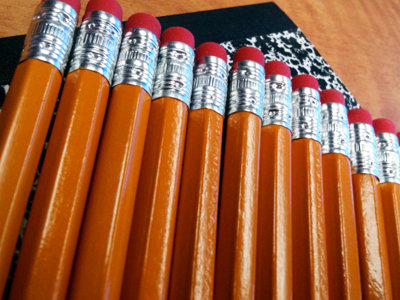Throughout much of the spring, there were little buzzes around the district that MPS was looking at supply lists on the individual school websites and tinkering with the idea of creating a uniform supply list across the district.
That buzz became reality this summer as MPS posted its 2011-12 Student Supplies List for Pre-School through Middle School as a PDF file on its website.
According to MPS spokeswoman Roseann St. Aubin, Superintendent Gregory Thornton wanted to ensure that the supply lists would not be a potential burden for families.
In addition to basics like crayons and pencils, it was not unusual for supply lists to include things like hand sanitizer, tissues and even cash.
“We hope the simple list, consistent from school to school, helps keep costs down for our families,” reads a statement on the MPS portal.
“High schools are exempt from using the uniform supply list,” the statement notes, “because the needs of older students vary.”
St. Aubin says the single supply list will also ease confusion and make it easier for parents to do back to school shopping. She says most area districts already have uniform supply lists.
“You can go to a place like Walmart and see the supply lists posted for another district and pretty much shop from that,” she says. “We wanted that for our families, too.”
According to St. Aubin, the superintendent’s office tabbed regional executive specialist Reggie Lawrence to convene a panel of principals and research supply requirements from many other districts to prepare the current list, which lists specific needs for pre-school, kindergarten, each grades from levels one to five and middle school.
There don’t appear to be exemptions for specialty schools, like Montessoris, whose classrooms might have more divergent needs.
Some teachers don’t think the lists accurately reflect the needs of their classrooms.
“I’ve reviewed the supply list with regard to first grade,” says Rene Blazel, who teaches at that level at Allen-Field Elementary on the South Side.
“There are some items on there which are entirely appropriate – book bag, supply box, erasers, pencils and crayons. However, there are many items that are simply not appropriate, or are inadequate, for this grade level.”
She notes that bottles of glue are “highly discouraged” in first grade, as are mechanical pencils (which are an option on the list for first grade).
“They are too young and liquid glue leads to huge messes and inappropriate use,” says Blazel.
“We would also never allow mechanical pencils in first grade – they are such a waste with the little ones, who break all the lead off within a day or two, and spend an inordinate amount of time clicking and playing with them. The list asks for two glue sticks – which are preferred – but two glue sticks will last a first grader about six weeks.”
Blazel notes that although markers are on the list, they’re not used in first grade at Allen-Field, and she thinks the number of crayons required is inadequate. The supply list also calls for two dry erase markers.
“I am not even sure what to say about that,” says Blazel. “Is that supposed to be for the teachers? Or the students? I wouldn’t put that on a supply list.”
There are supplies Blazel says her classroom needs and that she has traditionally included on her list but which aren’t on the uniform list; items like tissues, paper towels, hand sanitizer, child-safe scissors, copy paper.
“So the things we need … will have to be bought out of pocket if we want them in our room,” says Blazel. “We do consider most of those basic necessities for teaching first grade.”
Teachers should be able to count on support from their principals, though most school budgets are lean and stretched to the limit.
“It will be the responsibility of each school to fill in the gap,” says Nancy Martinez, incoming principal at Kagel Elementary in Walker’s Point, who says she plans to provide supplies to classrooms that teachers can no longer ask for from parents.
“My role is to prepare the perfect stage for the teachers to be able to teach and for the students to be able to learn,” she says.
“Whatever that equals – whether it’s supplies, whether it’s being the instruction leader – that’s what I’ll do, whether it’s through grants or through getting more kids in the classroom. But we are ready for that. I will do my best to do that – to try and fill in the gaps whenever possible.”
Kagel has a projected enrollment of about 365 students and Martinez hopes to nudge enrollment closer to her building’s capacity of 400.
“It’s so important to get to a certain number of students because then I could have a little fund on the side to supplement whatever (teachers) can’t ask for from parents.”


 i evaluate to yes even if there's no image
i evaluate to yes even if there's no image  i evaluate to yes even if there's no image
i evaluate to yes even if there's no image  i evaluate to yes even if there's no image
i evaluate to yes even if there's no image  i evaluate to yes even if there's no image
i evaluate to yes even if there's no image  i evaluate to yes even if there's no image
i evaluate to yes even if there's no image  i evaluate to yes even if there's no image
i evaluate to yes even if there's no image 